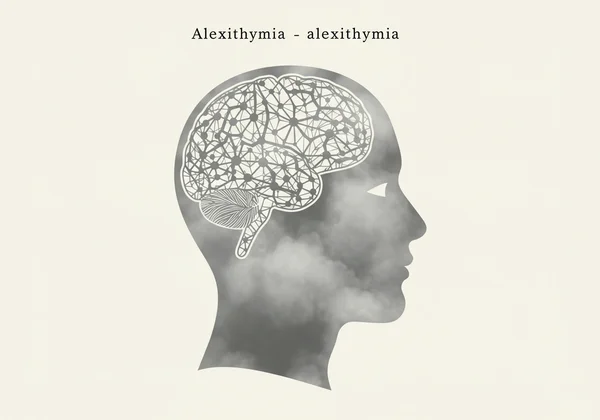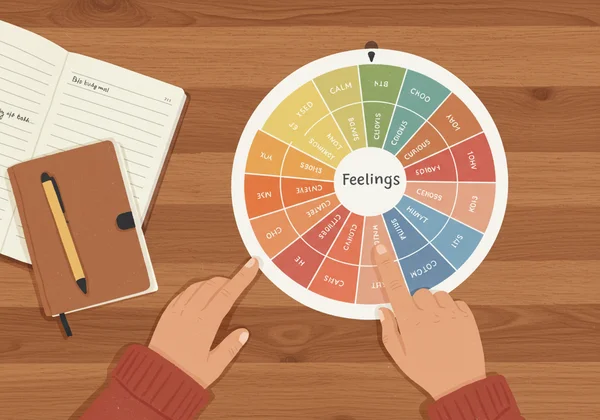Alexithymia and Autism: Take an Online Test to Understand the Link
If you're on the autism spectrum, you may have wondered if your challenges with identifying and describing feelings are a core part of your autism, or something else entirely. This feeling of uncertainty is common, leaving many to ask, how do you tell if you have alexithymia? The significant connection between alexithymia and autism is a topic of growing interest, and untangling the two can be a powerful step toward deeper self-understanding. Let's untangle these two concepts to help you find that clarity.
For many, the first step is gaining a baseline understanding of their own emotional landscape. An online alexithymia test can provide valuable initial insights into how you process feelings. This guide will walk you through the key distinctions and overlaps, helping you gain the clarity you deserve.
What is the Link Between Alexithymia and Autism (ASD)?
Alexithymia is not a mental disorder but a personality trait characterized by a marked difficulty in identifying, describing, and processing one's own emotions. While it can affect anyone, research shows a particularly strong correlation with Autism Spectrum Disorder (ASD). It’s crucial to understand that they are distinct concepts; you can be autistic without having alexithymia, and you can have alexithymia without being autistic. However, their frequent co-occurrence suggests a shared underlying mechanism.

Defining "Emotional Blindness" in Neurodivergent Individuals
One of the most useful LSI keywords to understand this connection is "emotional blindness." This term vividly describes the core experience of alexithymia. It’s not an absence of feelings, but rather a struggle to "see" or recognize them clearly. For a alexithymia neurodivergent person, an emotion might manifest as an unexplained physical sensation—a tight chest, a racing heart, a pit in the stomach—without a corresponding emotional label like "anxiety," "excitement," or "sadness." This disconnect between bodily sensations and emotional understanding is a hallmark of high traits of alexithymia.
How Common is Alexithymia in the Autistic Community?
The link isn't just anecdotal; it's backed by significant scientific evidence. Studies consistently show that alexithymia is far more prevalent in the autistic community than in the neurotypical population. Some research suggests that as many as 50% of autistic individuals also have co-occurring alexithymia. This high rate of overlap is a primary reason why emotional difficulties have often been mistakenly seen as an inherent part of autism itself, rather than a separate, co-occurring trait that requires its own specific strategies and support. Understanding this prevalence helps contextualize personal experiences within a broader scientific framework.
Shared Neurological Pathways: A Look at the Brain
Emerging neuroscientific research points toward shared neurological pathways as a potential explanation for the high correlation between alexithymia and ASD. Brain regions critical for emotional awareness and interoception (the sense of the internal state of the body) are often implicated in both. Key areas include the insula, which integrates bodily sensations with emotions, and the anterior cingulate cortex (ACC), which is involved in emotional regulation and social cognition. Differences in the structure and function of these networks in some autistic individuals may contribute to the challenges in emotional processing that define alexithymia.
Differentiating Alexithymia Symptoms from Autistic Traits
For an autistic person, distinguishing between core autistic traits and alexithymia symptoms can be life-changing. It helps pinpoint the exact nature of a challenge, paving the way for more effective coping mechanisms. Many people wonder about alexithymia symptoms and how they show up. While they can seem similar on the surface, their roots are different. If you're looking for answers, a confidential alexithymia questionnaire can be a great starting point.
Social vs. Emotional: The Empathy Distinction
A common misconception about autism is a lack of empathy. However, the empathy distinction is more nuanced. Many autistic people have strong or even hyper-active affective empathy—they feel others' emotions deeply, sometimes to an overwhelming degree. The challenge often lies in cognitive empathy, which is the ability to intellectually understand and predict what someone else might be thinking or feeling.
Alexithymia complicates this further. A person with alexithymia struggles to identify their own feelings, which naturally makes it difficult to recognize and share in the feelings of others. The issue isn't a lack of care, but a lack of emotional data to process.
Identifying Feelings vs. Sensory Processing Differences
Another critical area of confusion is the overlap between emotional processing and sensory processing differences, a core trait of autism. An autistic person might experience a shutdown or meltdown due to sensory overload from bright lights, loud noises, or strong smells. To an observer, this might look like an intense emotional reaction, but its trigger is sensory.
In contrast, a person with alexithymia might experience an internal state of distress but be unable to connect it to an emotional trigger. They might say "I feel bad" or "My body feels weird" without being able to name the feeling as "anger" or "fear." Disentangling whether a reaction is due to sensory input or an unidentified emotion is key to self-regulation.
A Simple Chart: Alexithymia vs. ASD at a Glance
To make these differences clearer, here is a simple comparison. This chart can help you begin to parse your own experiences.
| Trait / Challenge | Primarily Associated with Autism (ASD) | Primarily Associated with Alexithymia |
|---|---|---|
| Social Interaction | Difficulty with social cues, reciprocal conversation, and non-verbal communication. | Difficulty sharing emotions or responding to others' emotional expressions due to lack of self-awareness. |
| Empathy | Often strong affective empathy (feeling with others) but may struggle with cognitive empathy (understanding why). | Difficulty with both affective and cognitive empathy because one's own feelings are unclear. |
| Sensory Issues | Hypersensitivity or hyposensitivity to light, sound, touch, taste, or smell. | Physical sensations are felt but not interpreted as emotions (e.g., a racing heart is just a physical event). |
| Communication | May be literal, direct, or struggle with subtext and idioms. | Difficulty finding words for feelings; conversations about emotions are often avoided or confusing. |
| Repetitive Behaviors | Presence of "stimming" (self-stimulatory behavior), routines, and intense, specialized interests. | Not a core feature, though some may develop routines to manage an unpredictable inner world. |

How Can an Alexithymia Test Help Autistic Adults?
But how do you apply this knowledge to your own life? A well-designed alexithymia test for adults is an invaluable tool for moving from abstract information to personal insight. By answering questions based on established psychological concepts like the OAQG2, you can get a clearer picture of your emotional profile. You can try our free tool to see where you stand.
Gaining Clarity for Better Self-Advocacy
One of the greatest benefits of identifying high traits of alexithymia is gaining the language for self-advocacy. Instead of simply saying "I don't know how I feel," you can explain, "I have traits of alexithymia, which means I find it hard to name my emotions, but I can tell you my chest feels tight." This clarity empowers you in therapeutic settings, in relationships, and in advocating for your needs at work or school. It transforms a confusing internal experience into a definable, explainable trait.
Tailoring Coping Strategies and Therapeutic Approaches
Understanding the distinction also allows for tailoring coping strategies and therapeutic approaches. Strategies designed for autistic sensory overload (e.g., noise-canceling headphones, weighted blankets) are different from those for alexithymia (e.g., emotion journaling, body scan meditations, using a feelings wheel). Trying to solve an alexithymia-related problem with a sensory-based solution, or vice versa, is often ineffective.
Taking a test can be the first step. Our platform not only provides a quick score but also offers a unique, in-depth AI Personalized Report. This report can give you actionable steps and tailored insights, helping you build a roadmap for emotional growth. Get personalized insights and begin your journey toward greater emotional awareness.

Untangling alexithymia from autism isn't about adding another label—it's about gaining a more accurate map of your unique inner world. This clarity allows for more precise self-advocacy, more effective coping strategies, and a kinder, more patient relationship with yourself.
If you're ready to explore your own emotional profile, taking our free online alexithymia test is a valuable and confidential first step. Discover personalized insights in minutes and begin a journey toward a richer, more understood life.
Disclaimer: This website and its test are intended for educational and informational purposes only. They are not a substitute for a professional diagnosis or medical advice. Please consult a qualified healthcare provider for a comprehensive assessment.
Frequently Asked Questions about Alexithymia and Autism
Is alexithymia part of the autism spectrum?
No, alexithymia is not considered a core criterion or a part of the autism spectrum itself. It is a distinct personality trait that frequently co-occurs with autism. Many autistic people do not have alexithymia. Viewing them as separate allows for more accurate support and understanding.
Can you have alexithymia without being autistic?
Absolutely. Alexithymia can occur in the neurotypical population and is also associated with other conditions like PTSD, depression, and some anxiety disorders. It is a transdiagnostic trait, meaning it appears across many different diagnostic categories. The key is recognizing its specific impact on your life.
What is the best therapy for an autistic person with alexithymia?
There is no single "best" therapy, as effectiveness depends on the individual. However, approaches that specifically target emotional identification and literacy are often beneficial. Therapies like Somatic Experiencing, which connects bodily sensations to emotions, or modified Cognitive Behavioral Therapy (CBT) that includes a focus on building an emotional vocabulary, can be very helpful. The first step is identifying the need, which is where an alexithymia test can be a useful tool to bring to a conversation with a professional.